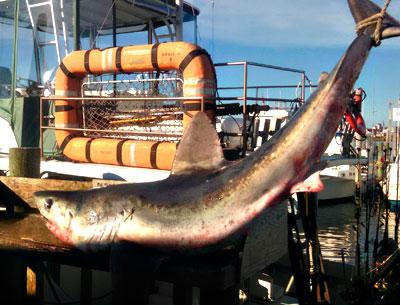The Big Guys Are Here

Capt. Burt Prince and his mate Gary Starkweather took the Susie E charter boat about 20 miles south of Montauk the other day and returned with a rarity, a porbeagle shark, 7 feet long, 54-inches in girth, and weighing just under 400 pounds.
“He stayed deep. We circled him and he corkscrewed up. Strange. We thought he was a mako, but he did not fight hard,” Prince said.
Porbeagles, Lamna nasus — some say the name is a conglomerate of porpoise and beagle, the beagle part due to its aggressive hunting instinct — are cold water sharks. Their physiology is similar to the great white in that they are capable of keeping their body temperatures above that of surrounding seawater, a feature that allows them to range into grounds richer in prey than more temperate latitudes. In the western North Atlantic, pregnant females migrate south to the Bahamas to give birth, usually four pups at a time.
They are found in both northern and southern hemispheres, in the Pacific, where they are known as salmon sharks, and in the Atlantic from the Gulf of Maine and the Grand Banks to Scandinavia. Porbeagles are as tasty or tastier than mako sharks, the reason that Norwegian longline fishermen depleted stocks to a dangerous level in the 1960s.
On Monday, Captain Prince pulled the frozen head of the big shark from the freezer at West Lake Marina. It would be pricey, he said, but the head was bound for the taxidermist. The meat was shared by the charter customers.
Don’t know if the big porbeagle bit into a J-hook, or into an inline, non-stainless-steel circle hook, but technically, the use of the old-style J-hooks to catch sharks became illegal in New York waters after Sept. 23, when Gov. Andrew Cuomo signed a bill outlawing them.
Circle hooks were developed by Japanese longliners. On a circle hook, the bend is more exaggerated, bringing the hook’s point almost full circle back toward its shank. The design results in the point of the hook catching the lips or jaw of a fish rather than the gut. Released fish have a far greater chance at survival, although anglers must train themselves not to strike at the first vibration of the rod tip. A violent yank only pulls a circle hook free of a hungry fish. Reeling does the trick.
Two local environmental activists, Rav Freidel of Montauk and April Gornik of North Haven, both instrumental in the founding in 2013 of the Montauk Marine Basin’s annual no-kill shark tournament, worked with State Assemblyman Fred W. Thiele Jr. and State Senator Kenneth P. LaValle to push the circle hook bill through the legislature. Both joined with the late Carl Darenberg, owner of the Marine Basin, to encourage local shark fishermen to use circle hooks.
As far as I know, circle hooks have not made it into the tackle boxes of surfcasters, although there’s probably no reason a bucktail lure armed with a circle hook wouldn’t work on a striped bass. Correct me if I’m wrong.
Let’s ask Jason Pecoraro, who on Sunday caught a 50.3-pound striper while surfcasting on Napeague using a bunker chunk as bait. The fish settled Pecoraro in first place in the tournament’s wader division and answered the question, “When are the big bass going to arrive?” Mary Ellen Kane leads the women’s division with a 13.04-pound striped bass.
Speaking of striped bass, one year ago, the striped bass board of the Atlantic States Marine Fisheries Commission initiated an addendum to the interstate management plan for striped bass “to consider new biological reference points and management option to reduce fishing mortality.”
Assemblyman Thiele has asked the Atlantic States Commission to consider the economic impacts of newly proposed striped bass fishing regulations. He explained that while bass are not being overfished, the number of mature breeders, in other words the spawning stock, has decreased. Managers are looking to reduce the number and size of bass taken.
Four options are being considered: Remain at the current harvest levels, reduce them by 25 percent in one year, reduce them by 17 percent in one year, or reduce the catch by 20 percent by way of a 7-percent reduction spread over three years. Mr. Thiele has told the Atlantic States Commission and the New York State Department of Environmental Conservation to choose the latter in order to minimize the impact on Long Island’s commercial and recreational fishing industries.
The draft addendum to amendment six of the Atlantic Striped Bass Interstate Fishery Management Plan can be found by under “fisheries management” at the commission’s website asmfc.org.
The commission and the Mid-Atlantic Fishery Management Council are also considering changes to the summer flounder, or fluke, regulations. A hearing on those amendments was held Monday at the Montauk Library and more will be held in coastal states from Massachusetts to North Carolina.
